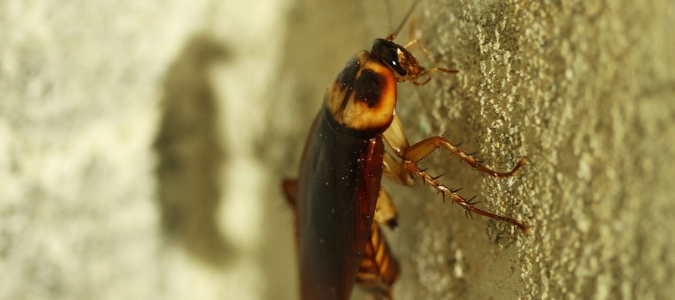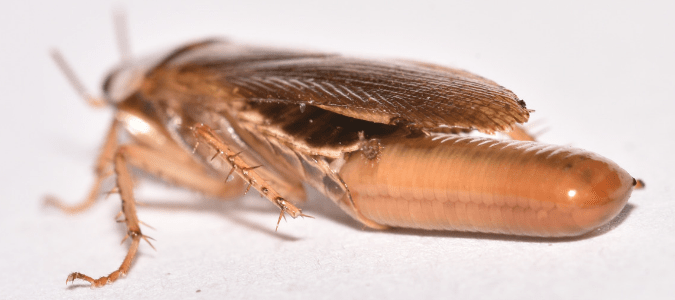What To Do About Cockroaches With Wings?

For most people, seeing a cockroach is unpleasant or even scary. But, when there’s a huge one flying through the air at you, it can take the feeling of panic and disgust to a whole new level. Are you wondering what to do about cockroaches with wings? Maybe you didn’t even realize cockroaches had wings, or that they could fly!
Certain types of cockroaches can indeed fly, such as the Pennsylvania wood cockroach. But, fortunately, you won’t come across this type of cockroach in Texas. Others can do something that looks like flying—namely, gliding on spread wings from a higher spot to a lower one. Either way, if you’re like most people, you don’t want any type of cockroaches infesting your home, whether they crawl or fly. Let’s learn more about what to do about cockroaches with wings. With this information, you can work to resolve or prevent an infestation in your home.
Here in Central Texas, if you’ve seen a cockroach with wings in or around your home, it’s most likely an American cockroach. These are the largest roaches commonly seen in people’s homes and yards. As you can see in the image above, they are medium reddish-brown color with a yellow band behind their heads. American roaches can grow to two inches long and a half-inch wide. They also do indeed have long wings they can use to glide short distances, usually from a spot that’s higher up to one that is a bit lower down. This can give the illusion that they are flying like a bird, even if they’re actually just launching off a high shelf and gliding across the room.
That said, there are also cockroaches with wings that may come into your home that don’t use their wings to fly or glide. Two species of cockroaches with wings that can’t fly are Oriental cockroaches and Turkestan cockroaches. Oriental cockroaches are dark brown to black in color and grow to an inch and a quarter long. Interestingly, male and female Turkestan cockroaches look different from each other. Male Turkestan cockroaches are brownish-yellow while females are a shiny, dark reddish-brown. Females can sometimes be mistaken for Oriental cockroaches. However, both male and female Turkestan cockroaches only grow to half an inch to just about an inch long.
How To Prevent Cockroaches With Wings From Entering Your Home
All these varieties of cockroaches naturally dwell outdoors. This means preventing a flying cockroach infestation inside your home first involves keeping them outside and away from your home. These roaches come indoors through small gaps or openings that allow them to access the home. These might include gaps around exterior vents or hose bibs, tears in window or door screens, or weep holes in brick edifices. Closing off these access points with caulk or wire mesh will help keep roaches out of your home.
Maintaining your yard will also help keep roaches away from the house. Roaches nest outdoors in old logs, tree stumps or piles of dead leaves. Clearing these away from your property will reduce the number of places where roaches might hide and breed.
Indoors, there are also several things you can do to keep roaches at bay. In the kitchen, storing food in airtight containers (including pet food) and wiping up crumbs, spills and splatters will reduce the access that roaches have to food sources. Be sure to clean your microwave too as leftover food bits can attract roaches to your microwave. Don’t keep dirty dishes in the sink or open bins of compost, garbage or recycling items in the house, either. All these things can attract roaches or encourage them to stick around in your home.
In the kitchen, bathrooms and utility rooms, fix any leaky faucets or pipes so roaches and other pests don’t have access to a water supply. Also take care not to overwater your house plants. This is because roaches can take up residence inside plant pots, nesting in the soil and living off the water. It’s also a good idea to empty your pets’ food and water bowls at night, when roaches are most active.
Roaches don’t just feed on regular human or pet food; they can also feed on things like paper, fabric and glue. Even if you keep your home impeccably clean and store all your food and garbage in sealed containers, your home could still harbor roaches if you have lots of cardboard boxes or books around. This is why reducing clutter around the house can also help keep roaches away.
Unfortunately, even the cleanest homes can have roach problems. All the above efforts work best in combination with other strategies and products that eliminate roaches in all stages of their life cycle. If you’ve been seeing cockroaches inside your home, it’s a good idea to reach out to a professional pest control company. Professionals can inspect your home, determine the extent of the problem and treat the entire area. A good pest management professional will also set up an ongoing treatment schedule. This way, you can have the peace of mind that comes from knowing your home is protected.

The American Cockroach Life Cycle
The American cockroach life cycle is surprisingly long. When conditions are right, these roaches can live for years! Considering this along with the fact that a female American cockroach can produce hundreds of eggs in her lifetime, it’s easy to imagine how quickly a roach population can grow out of control.
After mating, American cockroach females produce an egg case. Roach egg cases are small, brown and hard, and are scientifically known as an ootheca. These oothecae contain between 15 and 20 eggs that will produce baby cockroaches within a few weeks.
These baby cockroaches, known as nymphs, will shed their exoskeletons many times over the course of growing from very small babies into full-grown adults. The entire process from nymphs emerging from the egg case to developing into adult cockroaches can take six months. Then, adult roaches can live for a year or more, given the right conditions.
Seeing cockroaches in your home, whether alive or dead, can be a sign of an infestation, but there are also other signs to look out for.
Signs of an American Cockroach Infestation
Spotting oothecae—the small, hard egg cases laid by cockroaches—is another sign. You may find roaches have laid eggs in hidden areas, like behind a piece of furniture. Spotting baby or nymph cockroaches (again, either alive or dead) also indicates you have an active roach population. Cockroach feces, which looks like brown spots, streaks or bits of “dirt,” is another sign. You can often find droppings on shelves, inside cupboards or on wallpaper.
If you’re seeing any of these potential signs of a cockroach infestation, it’s time to contact a pest management specialist. A specialist will come to inspect your home and determine the best way to combat these pests. Hiring a professional is often the most efficient way to deal with roaches, and it’s also often the safest way. These professionals have access to products and techniques that will get rid of roaches while keeping you and your family safe. Professionals can ensure that roaches stay awhile while you sleep and while you go about your day.

Do Cockroaches Die in the Winter?
If you’ve dealt with a cockroach problem in your home, you may have noticed that you don’t see as many of these pests in winter as in summer. It’s almost as if their numbers naturally go down during the colder months and then rise again during warmer ones. Do cockroaches die in the winter, or do they somehow hibernate or hide away until spring?
The answer is that it depends. Cockroaches are tropical creatures that thrive in warm, moist climates which is why these pests are so populous in Central Texas. They will die of exposure to the cold, when temperatures reach the low teens (Fahrenheit). This is actually why cockroaches sometimes wander indoors when the weather outside starts to get colder. Many people’s homes offer cockroaches not just the food and water they need, but also the steady warmth and shelter.
Unfortunately for many of us, even outdoors, cockroaches can survive a brutally cold winter. These resilient pests have many ways of protecting themselves from freezing cold temperatures. They might head underground into sewers or other spaces where it’s much warmer. Or, they might build nests within protected spaces like rotting tree stumps or rock walls that offer enough protection from the cold for them to survive until spring.
Interestingly, many types of cockroaches do something similar to hibernating in winter. When it’s cold outside, it’s often colder indoors too, at least by a few degrees. Cockroaches both outdoors and inside people’s homes can go into a hibernation-like state of dormancy. In this state, their metabolism drops and they aren’t as active. They will pick up activity and begin growing again—and feeding, and breeding—when springtime returns and temperatures get warmer again.
If you suspect you have a cockroach problem in your home, it’s time to contact a pest control company to address the problem before it gets bigger. Many times, people who try to deal with a cockroach infestation on their own wind up prolonging the problem before finally contacting an exterminator in the end. A good exterminator will work with you to develop an effective plan to combat roaches that works for every person and pet living in your household.
Chem-free Can Make Your Home Less Hospitable to Roaches
Whether you have German or American cockroaches, it’s enough to send a shiver down your spine. Instead of dealing with these pests, contact Chem-free Pest Control. We start our treatment plans by finding out how we can make your home less welcoming to roaches. Then, when necessary, we turn to other pest treatment options.

